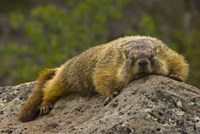Animals Need Sleep Too
Post Register June 27, 2013
If there is one thing I am known for it is the appearance of dozing through long and tedious meetings. When my kids were young and a full night’s sleep was rare, I suppose I had an excuse. These days, I just tell my critics that if they want me to stay fully engaged, they need to have more interesting meetings.
I am in good company though. Virtually all animals sleep in some fashion. How much, why, how, and where they sleep is almost as interesting as what they do when they are awake. For instance, a brown bat may sleep for 20 hours a day hanging upside down. A giraffe sleeps for only three 30 minute power naps a day. When bottlenose dolphins sleep, half their brain is still awake, allowing them to swim and surface to breathe. Even fire ants have been documented sleeping up to 250 times a day in 1.1 minute intervals.
Sleep is defined behaviorally as a periodic cessation of physical activity and less responsiveness to external stimuli. The animal assumes a characteristic posture such as lying down and closing eyes, and unlike hibernation, is easily aroused from sleep.
Sleep is more complex than that though. Both birds and mammals have two kinds of sleep; slow-wave sleep (SWS) and REM (rapid eye movement) sleep. During the REM phase of sleep, the brain is highly active and muscles relax, in what is called functional muscular paralysis. For humans, dreams occur in REM. REM sleep also supports cognitive abilities such as consolidating memories. A good night’s sleep with plenty of REM can improve memory of things learned that day by up to 15 percent. That should make college kids re-think all-night cramming sessions.
While all mammals enter into a REM phase of sleep, research has determined that animals with larger brains for their body size need a higher percentage of REM sleep. The more intelligent the animal, the more REM is needed. Humans may have up to 120 minutes of REM a night, cycling between SWS and REM sleep every 1.5 hours. Birds, on the other hand, get much less REM, but appear to enter into that phase every 10-15 minutes.
Although the exact role of sleep is still a mystery, it is clear that going without sleep can have dire consequences. Experiments with even simple creatures like fruit flies indicate that cognitive abilities, such as learning and memory, are impacted with sleep deprivation. A study conducted on rats found that cognitive impairment began quickly when the rats were denied REM sleep. Worse, within two weeks, the rats died, even though they had rest, just not REM sleep. A similar experiment with humans was terminated after several nights, because serious personality issues developed in the subjects.
The number of hours an animal sleeps is variable. For instance, larger animals, such as elephants, bison, and zebras, tend to sleep much less than smaller animals. Predation risk also plays a role, not only in how much an animal sleeps, but how soundly as well. For instance, like marine mammals, many birds practice unihemispherical sleep, sleeping literally with one eye open to watch for predators. African lions, with little worry of predators, may sleep soundly even in the open.
I’ve was up early finishing this column and I’ll need to catch up with a nap sometime today. Maybe I will be lucky and find an exceptionally boring meeting.

Dozing on a rock, this marmot still routinely opens its eyes to scan for predators. It reserves REM sleep for when it is safe in the burrow.